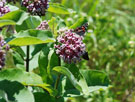COMMON MILKWEED
|
 |
| File Size: 46 KB |
|
|
|
Asclepias syriaca L.
|
| Konza Prairie, Riley County, Kansas |
| Perennial |
| Height: 2 - 5 feet tall |
| Family: Apocynaceae - Dogbane Family |
| Flowering Period: June, July, August |
|
| Also Called: | | Milk plant, wild asparagus, silkweed, wild cotton. | | Stems: | | Erect, usually solitary, stout, simple, sparsely to densely pubescent. | | Leaves: | | Mostly opposite, ascending to spreading, broadly egg-shaped to elliptic or oblong, 2.4 to 12 inches long, 2.2 to 4.4 inches wide, firm, sparsely to moderately soft hairy above, finely woolly below; tip blunt or rounded with short, abrupt, sharp point; margins not rolled underneath; on stalks .1 to .6 inch long. | | Inflorescences: | | Umbels, few to several, 20- to 130-flowered, in upper leaf axils; on stalks .5 to 5.5 inches long. | | Flowers: | | .4 to .7 inch tall; stalk slender, .6 to 1.8 inch long; calyx lobes 5, lanceolate, .1 to .2 inch long, green to purplish, densely pubescent; corolla lobes 5, elliptic-lanceolate, .25 to .4 inch long, reflexed, rose to purple or rarely white, minutely hairy on the back; hoods ovate, attached near base, spreading, up to .2 inch long, somewhat fleshy, tip rounded, margins with a pair of prominent teeth near the midpoint; horns sickle-shaped, united to lower 1/3 of hood, arching. | | Fruits: | | Pod, spindle-shaped, 2.8 to 4.4 inches long, .75 to 1.4 inch thick, smooth to densely covered by projections, woolly, erect to ascending on downward-curved stalks; seeds many, broadly ovate, 1/4 to 1/3 inch long, tufted with long, silky hairs 1.4 to 1.8 inch long . | | Habitat: | | Found along banks of ponds or waterways, roadsides, edges of woodlands, and in open disturbed sites or waste areas. | | Origin: | | Even though "syriaca" means Syrian, this plant is native to North America. | | Toxicity: | | All parts of this plant are poisonous to a greater or lesser degree. The shoots were thoroughly boiled with a change of water before being eaten. | | Uses: | | In the spring, a number of Native American tribes cooked the young shoots and ate them as an asparagus-like food. Common milkweed was also used medicinally by Native Americans. | | Comments: | | Formerly treated as Asclepiadaceae - Milkweed Family. |
|
| Milkweed infloresence |  | | 85 KB | | Reno County, Kansas |
| | Milkweed flowers |  | | 80 KB | | Reno County, Kansas |
| | Milkweed leaves |  | | 98 KB | | Reno County, Kansas |
| | Milkweed |  | | 88 KB | | Chase County, Kansas |
| | Milkweed infloresence |  | | 70 KB | | Chase County, Kansas |
| | Milkweed leaves |  | | 119 KB | | Chase County, Kansas |
| | Milkweed fruit |  | | 152 KB | | Geary County, Kansas |
| | Milkweed fruit |  | | 131 KB | | Atchison County, Kansas |
| | |
|
|
|
|
|
|